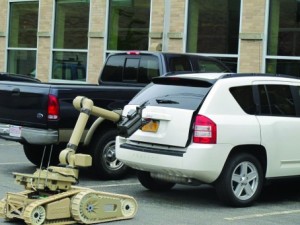 In science fiction, robots have been solving cases and apprehending criminals for a while. From Robocop to Terminator to THX 1138 the idea that robots may replace police officers has in recent years begun the transition from fiction to fact.
In science fiction, robots have been solving cases and apprehending criminals for a while. From Robocop to Terminator to THX 1138 the idea that robots may replace police officers has in recent years begun the transition from fiction to fact.
Right now, Robot Combat League demonstrates some of the most advanced hand-to-hand combat-capable robots and the military continues to develop all kinds of fighting machines. But in terms of local law enforcement, the recent events in Boston bring into focus the question of to what extent robots may be able to assist, if not replace police officers in dangerous situations.
Initially, accounts circulated that a robot helped remove the tarp from the boat where Dzhokhar Tsarnaev hid as police scoured Watertown and Cambridge. Later information revealed that the robot used to remove the tarp from the boat was actually a mechanical arm extending from a law enforcement vehicle. Even though the owner of the boat had already peeked under the tarp, the use of the mechanical arm allowed law enforcement to remain at a safe(r) distance, poised and ready for whatever they would find.
In my head, I rewrite the scene so some terrifying version of Robocop exposes an unsuspecting Tsarnaev and proceeds to deliver robojustice. I’ve clearly watched far too much science fiction.
However, in Watertown, police did use a robot to examine a car, presumably the green Honda allegedly abandoned by the suspect as he fled. A similar robot searched for bombs in Cambridge around the suspects’ residence. Another removed suspicious packages from a car in New York on Friday. In addition to locating, removing, and diffusing explosive devices, these robots can also conduct controlled detonations.
These kinds of robots are becoming increasingly common in investigations, as well in places such as Afghanistan and Iraq, when explosives or bomb threats are involved. Police robots are neither sentient nor autonomous—they cannot think or make decisions. They’re controlled remotely, either via radio signals, like a remote-controlled car (which necessitates having an onboard battery much like those used in cars), or a power cable from a console containing software made specifically for the robot. Some models use joysticks, while others take commands input via a keyboard. Regardless of the mechanism, the control consoles are always portable, which allows police to keep a distance but maintain visual contact with the robot.
These robots often have treads, like tanks, though some have special wheels that can be individually controlled to help maneuver over rough landscapes. Some can navigate stairs and right themselves if they get tipped over. Their casing helps protect them from weather—many of these robots can move in substantial amounts of water—and sometimes even from explosions.
Police robots come equipped with at least one camera (often two or three) that feeds video to the console. Depending on the complexity of the robot, these cameras might have night and/or infrared vision. Most police robots also have an audio system that allows police to hear what’s happening. The audio-visual capabilities enable the use of these robots for surveillance. Many have GPS tracking systems.
These robots need to be dexterous enough to handle and remove objects, so they come equipped with at least one jointed “arm” that can extend and flex, allowing the robot to maneuver into tight spaces, as well as grasp, and move objects. These robots can also move heavy objects, including people, from dangerous areas.
Some police robots have sensors that allow them to detect chemical, biological, or radioactive weapons.
iRobot, a Massachusetts company, produces the PackBot reportedly used to search the car thought to have been driven by the Boston bombers. The PackBot, which can be programmed for specific missions, can be used to detect explosives, as well as neutralize and dispose of them. Similar robots have long been used to diffuse and remove and IEDs (improved explosive devices) such as the ones used in Monday’s bombing and abroad in places like Iraq and Afghanistan. The PackBot can also be used in hazmat situations, as well as to aid infantry troops in combat and emergency first responders.
iRobot also has a Warrior robot, which is bigger and more powerful than the PackBot (it can move an entire car, or, as seen in the video, pop the trunk and remove a hazardous device from the backseat).
More police robots can be seen (and purchased, if you’re feeling unsafe and wealthy) here.
More advanced models, such as the SWAT robot developed by Howe & Howe Technologies in Waterboro, Maine, offer increased protection to first responders and officers engaged in confrontations. This model, the first “designed specifically for ballistic shield purposes,” also has the capability to break down doors and tow away cars, and was ironically set to be unveiled in Boston last week. While it carries a hefty $98,000 price tag, it seems cheap when compared to the cost of human lives.
Given the relative ease of making IEDs (directions can be found on the internet, of course), which were responsible for the Boston Marathon explosions, the Oklahoma City bombing, and the detonation that killed 77 people at a youth camp in Norway, among others, experts predict that IEDs will become an increasingly serious and commonplace problem. While I have nothing but admiration and faith in law enforcement, especially after the events of the past week, I’m further comforted reassured by knowing that they—and all of us—have robotic back-up.


